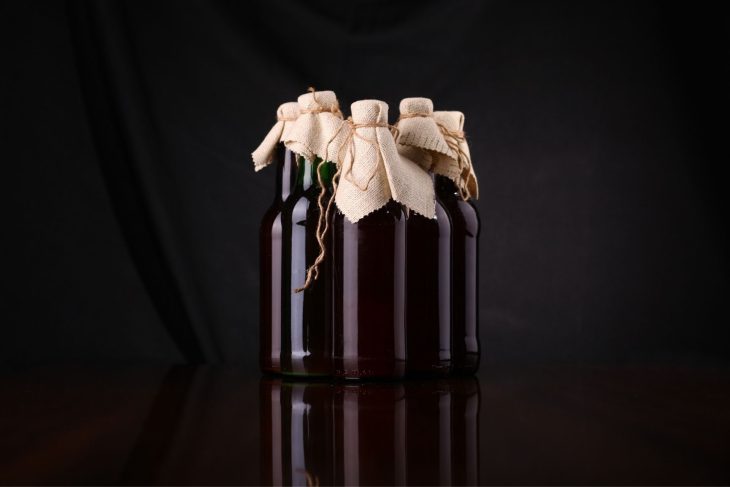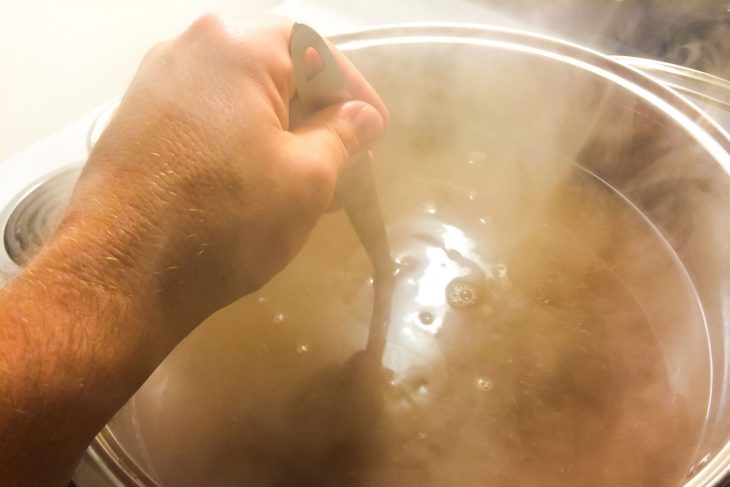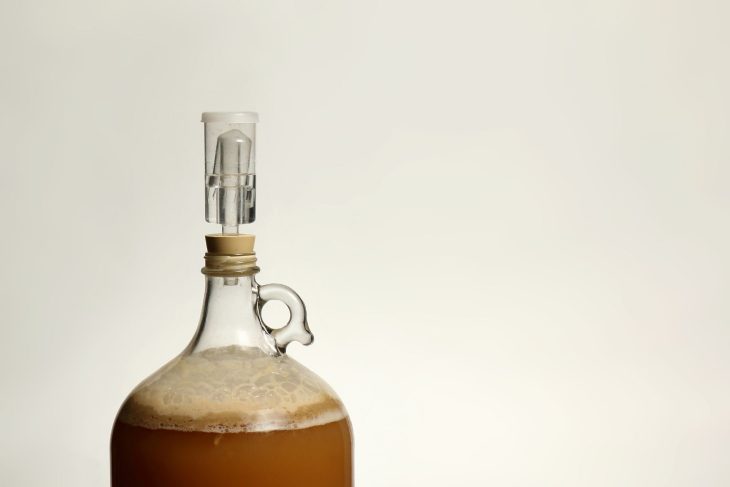Hey there! This site is reader-supported and we earn commissions if you purchase products from retailers after clicking on a link from our site.
When you are starting out as a beginner home brewer, you are going to be swamped with recipes. You may even feel tempted to start out with some more complicated beers, like an Imperial IPA or barleywine. Don’t get in over your head. You will see in our list of the most popular types of beer to home brew that even simple can be time consuming. Learning the basics, though, helps you stamp out mistakes before you try more complex beers.
For the beginning, it is recommended that you purchase home brewing kits with all the ingredients included, since you will never have to measure anything out. But, if you want to gather the ingredients yourself, we have included several recipes for you to try (along with some variations).
Ready to familiarize yourself with nine popular types of beer to home brew? Let’s go!
Table of Contents
- 1. SMASH Pale Ale
- 2. Dry Irish Stout
- 3. Dunkelweizen
- 4. American Amber
- 5. American Wheat Ale
- 6. American Pale Ale
- 7. Porters
- 8. German Hefeweizen
- 9. Belgian Saison
- What Type of Beer Should You Pick When Starting Out?
- Is There Any Beer That is Difficult to Brew?

1. SMASH Pale Ale
SMASH stands for “Single Malt and Single Hop.” You will notice later on in this list that many beers require 2-3 types of hops to get well-rounded flavor. Yet, with one variety of malt and hop in your beer, you can truly fine tune the flavor. For instance, you might use a classic malt, like English Maris Otter, and pair that with a popular hop, like Cascade, to get a citrus note in the beer. By learning which malts and hops pair well together, you create a truly satisfying SMASH Pale Ale without too much effort.
Ingredients:
- 5-6 gallons of water
- 8 lbs of Maris Otter Liquid Malt Extract
- 4 ounces of Cascade hops (optional: Kent Golding hops)
- White Labs California Ale Yeast or Wyeast American Ale Yeast
Directions:
1. Heat your water. Nearing boiling point, add in the liquid malt extract.
2. After the boiling begins, add about 1 ounces of your chosen hops. After 50 minutes have passed, add in another 1.5 ounces. The final 1.5 ounces is added in the final minute of boiling.
3. Add your wort to a cooler and let the temperature drop to 20°C (68°F). Pitch the yeast.
4. Fermentation takes about 10 days. Once the beer has reached a final gravity of around 1.013, you are ready to bottle or keg it.
2. Dry Irish Stout
You may hear this type of beer called either “Irish Stout” or “Dry Stout” or the fusion of the two. And when you think of an Irish Stout, you probably imagine Guinness. The reason such beers are called dry is due to the flavor—a roasted, bitter flavor—that lacks the sweetness of English stouts. Traditionally, Irish stouts also had more carbonation, since Dublin’s water supply was different than London’s.
There are a couple of characteristics of Dry Irish Stout to keep in mind. First, most recipes use unmalted barley. Next, the beer will have a dark brown or black color and may smell of chocolate or coffee. There is virtually no hop flavor, though you can add in some to add layers to the profile.
Ingredients:
- 1 lb flaked barley
- 1 lb roasted barley
- 6 lbs Maris Otter Liquid Malt Extract
- 2 oz Kent Goldings hops – boil for about 60 minutes
- Wyeast American Ale yeast or White Labs California Ale yeast
Directions:
1. Steep the barley (both flaked and roasted) for 30 minutes at 65°C (150°F).
2. Remove the grain and raise the liquid’s temperature to boiling. Once boiling, add your malt extract, hops, and continue to boil for 60 minutes.
3. Remove the hops after 60 minutes.
4. Cool your wort before you begin fermenting. Keep the fermentation temperature at around 20°C/68°F.
5. Ferment your beer for about 7-10 days. Before bottling or putting into a keg, take a gravity reading.
Going for an all-grain version? Swap out the malt extract and use just the malt. You will need to mash it at 65°C/150°F.
3. Dunkelweizen
Dunkel is the German word for “dark,” and weizen is “wheat.” So, a dunkelweizen is a dark wheat beer. Though it looks nearly black when poured into a glass, the flavors are all warm and welcoming. You get sparks of nutmeg, apple, clove, banana, and vanilla on the tongue. Since the grains that make up a dunkelweizen are roasted then caramelized, you get a rich beer with amazing depth and smoothness.
If you plan on brewing up some dunkelweizen, make sure you have the appropriate glasses on hand. Dunkelweizens taste best when served in a tall glass. Make sure you leave enough room for the foamy head.
Ingredients:
- 2.7kg (6 lbs) wheat liquid malt extract
- 56g (8 oz) German dark crystal malt (65°L)
- 56g (8 oz) German Munich malt
- 56g (8 oz) German Vienna malt
- 1 ounce 3.5 HBU Hallertau Hersbrucker hops
- ¾ cup corn sugar or 1 ¼ cup dry malt extract (primer)
- White Labs Hefeweizen ale yeast or Wyeast Weihenstephan yeast
Directions:
1. Steep your grains at 68°C (155°F) for about 30 minutes. After steeping, remove the grains and rinse them with 74°C (165°F) water.
2. Add in the wheat malt extract and stir.
3. Bring the mixture to a boil then add your hops. Boil them for about 60 minutes.
4. After boiling, chill the wort to about 23°C (70-75°F). Add your yeast after the wort has cooled enough.
5. It takes between a week to 10 days for fermentation to complete.
4. American Amber
The traditional amber ale was originally brewed during the time of the American Wild West. Though there are many variations of amber ale, most of them have a defining caramel-and-malt flavor along with just enough hoppiness to give it a bite. American amber ale also has a characteristic reddish tint.
This type of beer will not smell hoppy. Instead, the hops and malt are balanced. Ideally, you want to use a type of hop that does not have a lot of alpha acid. You can also experiment with different kinds of malts to experience the vast array of flavors.
Want to try a variation of American Amber Ale? Check out this recipe:
Ingredients:
- 1.4 kg (3.0 lbs) Amber dry malt extract
- 1.5 kg (3.3 lbs) Coopers light malt extract
- 224 grams (8 oz) Crystal malt 40°L
- 56 grams (2 oz) Crystal malt 135-165°L
- California Ale yeast (WLP001)
- 1 tsp Irish moss
- ¾ cup priming sugar
- 14 g Chinook hops
- 56 g Willamette hops (split into two groups of 28g)
Directions:
1. Grab your brew pot and fill it with about 11.4 liters (3 gallons) of freshwater. Raise the water temperature to about 66ºC (150ºF).
2. Put steeping grains into a muslin bag and add the bag to the brew pot. Steep them for about 15-20 minutes before removing.
3. Stir in your malt extracts until all are dissolved.
4. Return your wort to a boil. Watch your liquid carefully to make sure it doesn’t boil over.
5. Once you have a rolling boil, add the Chinook hops. Boil the water with those hops only for about 30 minutes.
6. After 30 minutes have passed, add the first handful of Willamette hops.
7. 45 minutes of boiling, add the 1 tsp of Irish moss.
8. 55 minutes in, add the second handful of Willamette hops.
9. Once the mixture has boiled for a total of 60 minutes, turn off the heat and remove your brew pot from the heat. Strain out the hops. Make sure you cool the wort down as fast as possible by utilizing a wort chiller.
10. After the wort has reached 25ºC (75-80ºF), pour the liquid into the fermenter.
11. Add in about 19L (5 gallons) of fresh water to the fermenter. Mix the water and wort together.
12. Add your yeast.
13. Maintain a temperature of about 19ºC (65-70ºF) over the next 7-10 days to allow the beer to ferment. Once you start seeing signs that the beer is ready, you can pour it into a keg or bottle it. Wait an additional 10-14 days after bottling before drinking.
5. American Wheat Ale
When you hear about wheat ale, you might immediately think about a Bavarian or German Hefeweizen (also in this list). For now, we’re talking about the American version of the popular German style. The main difference between American and German wheat ale is in the yeast and hops. The American version uses more potent hops, whereas the German beer’s hop profile is more subtle. Plus, American Wheat Ale uses American ale yeast.
Unlike heavier beers, a wheat ale is going to be light, bubbly, and fluffy –noted by the noted. The body is slightly cloudy, and the scent is a fusion of clove, citrus, and banana. This is an excellent beer to sip on throughout the year, so it will always be a welcome brew to have around.
You can read the procedure for the German Hefeweizen and just add the American versions of the hops and malt, or you can purchase an extract ingredient kit. Typically, a kit will contain 1 to 2 ounces of American hops, ale yeast, and wheat malt extract.

6. American Pale Ale
One of the beers that most homebrewers begin with is the classic American Pale Ale. Pale ales have a greater IBU than your standard amber ale, and they also have more alpha acid. Unlike some milder beers, a pale ale using American hops will have a bold flavor, aroma, and bitterness. And that boldness is rounded out by the silky malt. If you want to make a great pale ale, focus on the hops first and then use a pale or crystal malt to get just a touch of sweetness.
A recommended hop for American Pale Ale is Cascade. The hop lends a citrus tone to the beer—if you add it at the right time. To make a masterful American Pale Ale, add the hops to the wort within the last 15 minutes.
The only difference between American Pale Ale and SMASH Pale Ale is that you can use a variation of hops and malts with the American version. You can follow the same directions as you do with a SMASH Pale Ale. Optionally, you can grab an ingredient kit for home brewing. It will contain a crystal malt, light malt, 3-4 oz of mild hops, such as Cascade, and some ale yeast. With all that flexibility, it is no wonder that pale ales are some of the most popular types of beer to home brew.
7. Porters
Many beginners will confuse a brown ale and porters on first glance. Porters, whether you are doing the English or American style, utilize dark, chocolaty malts. Because of this, you can make a couple of mistakes while brewing it, and it won’t alter the flavor or effervescence of the beer too much. The ingredients used in Porters—and deep, rich flavors—have the ability to cover one another up, so any inconsistencies will not be as pronounced. In fact, you may want to try making a Porter the first time around.
You can simply purchase a home brew beer kit that comes with a dark malt extract, a specialty grain or chocolate malt, and about 1-2 ounces of hops. The hops are often mild. Simply follow the directions in the kit to make a satisfying porter.
8. German Hefeweizen
Want a fantastic beer with out-of-this-world flavor? You are in luck. Not only is the German Hefeweizen delicious, it is also insanely easy to whip up. You will need to procure German Hefeweizen yeast to make your recipe work, but other than that, the ingredient list is short and sweet, and brewing up the beer is less labor intensive.
Here is another reason why you should start with a Hefeweizen: this recipe tolerates a wide range of temperatures for fermentation. If you use higher temperatures, you get a banana or bubble gum flavor. Also, Hefeweizen beers have a lot of carbonation, making it ideal for bottling.
Ingredients:
- 8.5 lbs Wheat Liquid Malt Extract or 60/40 or 50/50 wheat and barley blend
- 1 oz Hallertau Hops
- Wyeast Weihenstephan Weizen yeast or White Labs Hefeweizen
Directions:
1. Bring water (5-6 gallons) and wheat liquid malt extract to a boil. After the mixture is boiling, you can add the hops. Boil for another 60 minutes.
2. Cool the wort to about 18.3°C (65°F).
3. Pitch the yeast and let ferment. Allow for 10 days of fermentation before bottling or kegging.
9. Belgian Saison
Have you ever heard of a Saison beer? Now is the time to get acquainted. The Belgian Saison is refreshing, thirst quenching, and great for beating summertime heat. Beginners do well with brewing up a saison, so long as you do not deviate from the recipe. You must emphasize the fermentation period, since that is when the beer gains most of its flavor and depth. Choose your yeast carefully, as well. You may be tempted to use Classic Belgian Saison yeast, but it is better to go along with Wyeast French Saison yeast, since it is more consistent.
Ingredients:
- 7.5 lbs Extra Light Liquid Malt Extract
- 1 lb Dextrose (corn sugar)
- 1 lb Acidulated Malt
- Sorachi Ace hops – dry hop 2 ounces for 3 days and save another 4-5 ounces for the brewing
- Wyeast French Saison yeast
- 6 gallons of water
Directions:
1. At 65°C (149°F), steep the acidulated malt for about 30 minutes. Remove the grains then bring the 6 gallons of liquid to a boil.
2. Once the wort is boiling, use 0.5 ounces of Sorachi Ace hops. Continue boiling for 60 minutes.
3. Add in another 0.5 ounces of Sorachi Ace hops at 30 minutes in.
4. After 60 minutes, toss in 3 ounces of hops then swiftly turn off the heat. Chill until the liquid reaches 18°C (66°F).
5. Add yeast then wait 7-10 days for fermentation.
6. Using a nylon bag, add in the dry hops after the beer reaches the desired final gravity (1.010). Keep the dry hops in the beer for another 3 days before removal.
What Type of Beer Should You Pick When Starting Out?
Any of the beer types that we mentioned above are going to be ideal for the beginner. You do not need much experience with homebrewing to create a beer that is tasty. The important thing is that you choose the right method of homebrewing. Though the ingredients and directions listed are easy enough to follow, beginners should use something called an extract kit. You will get to cut out some of the more labor intensive steps with an extract kit.
If you do not have such a kit, then choose the beer type with ingredients that you can easily find.
You may have also heard the rumor that IPAs are the easiest kind of beer to make. They may be easier to brew than lagers, but that does not make them the easiest. IPAs use the same process as lagers. The only change is that IPAs are more forgiving, since any mistakes can be corrected enough where the taste is unaffected.

Is There Any Beer That is Difficult to Brew?
As a home brew beginner, the one beer style you should avoid for now is the lager. Since lagers have specific fermenting periods and require a certain environment for brewing, it is easy to mess up. Another beer style that is challenging for beginners is any of the wood-aged varieties, Lambic beers, and rye, oat, or wheat beers.
Ready to give these popular types of beer to home brew a try? Which one are you starting with first? We would love to hear about your adventure
Recommended Reading
Choosing the Best Base Malts For Your Beer
What are base malts? Let's delve into of the malting process and learn how malting fits in with the homebrewing process.
Torrified Wheat Buyer’s Guide For Home Brewers
When you start looking into older recipes from the UK and Europe, you may notice that those recipes call for the same ingredient: torrified wheat.
The Complete Guide to Growing Hops At Home
Hops are expensive, so growing hops at home is an economical choice. Besides, wouldn’t it be nice to tell others you made your beer with homegrown hops?
How Much Does a Beer Keg Cost?
It depends on the size and what the keg is holding. Some kegs may only be around $50, while others are going to set you back by $150-$200.
Non-Alcoholic Mead Recipes & Mead-Flavored Alternatives Without Alcohol
For thousands of years, people have succumbed to the alcoholic effects of mead. Fortunately, we live in an era with technologies that make booze a little less, uh, boozy.
Bottle Priming: How to Use Priming Sugar to Bottle Beer
As with all things related to home brewing, using priming sugar is an art that requires some skill and knowledge to get right. If you have ever wondered about bottle priming, you have come to the right place.

